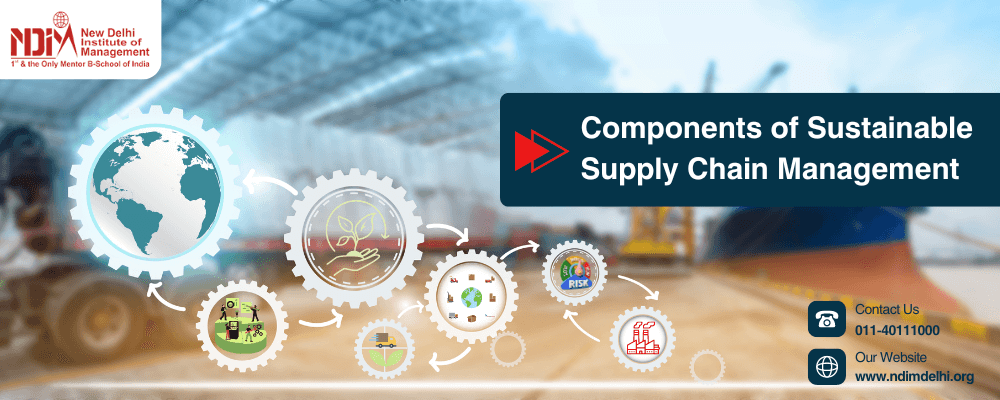Components of Supply Chain Management
In today’s dynamic business environment, sustainability is no longer a mere buzzword; it has become a strategic imperative. Sustainable Supply Chain Management (SSCM) is an integral part of this paradigm shift, ensuring that companies not only achieve economic goals but also address environmental and social responsibilities. For MBA students, understanding SSCM is crucial as it forms the backbone of responsible business operations. This blog explores the three fundamental components of SSCM: Economic, Environmental, and social sustainability, providing insights into how these elements converge to create a resilient and responsible supply chain.
1.Economic Sustainability
- Profitability and Cost Management
At the core of economic sustainability is the need for a supply chain to be financially viable. Companies must ensure that their supply chain operations are cost-effective and contribute positively to the bottom line. This involves optimizing processes to reduce waste, enhancing efficiency, and leveraging technology for better resource management. For instance, adopting Just-in-Time (JIT) inventory systems can significantly reduce holding costs and minimize waste.
- Innovation and Investment
Investing in innovative technologies and practices is crucial for maintaining economic sustainability. Companies that invest in advanced analytics, the Internet of Things (IoT), and blockchain technology can achieve greater transparency and efficiency in their supply chains. These technologies enable better demand forecasting, inventory management, and real-time tracking, which can lead to substantial cost savings and enhanced customer satisfaction.
Application Invited for PGDM 2026-28 at NDIM
- Risk Management
Economic sustainability also involves managing risks that can disrupt the supply chain. This includes geopolitical risks, natural disasters, and market fluctuations. Diversifying suppliers, creating contingency plans, and maintaining strategic stockpiles are some of the strategies companies use to mitigate these risks. For MBA students, understanding risk management is vital as it prepares them to navigate complex global supply chains.
2.Environmental Sustainability
- Resource Efficiency
Environmental sustainability focuses on minimizing the ecological footprint of supply chain activities. This includes using resources more efficiently, reducing emissions, and managing waste. Companies are increasingly adopting circular economy principles, where materials are reused, refurbished, and recycled to extend their lifecycle and reduce environmental impact.
- Green Logistics
Transportation and logistics are significant contributors to a supply chain’s environmental footprint. Green logistics involves optimising transportation routes, using energy-efficient vehicles, and adopting alternative fuels to reduce carbon emissions. For example, companies like DHL and UPS are investing in electric and hybrid delivery vehicles to lower their carbon footprint.
- Sustainable Sourcing
Sustainable sourcing practices are critical for environmental sustainability. This means procuring materials and products from suppliers who adhere to environmental standards and regulations. Companies are increasingly using certifications like ISO 14001 and the Forest Stewardship Council (FSC) to ensure their suppliers meet environmental criteria. Sustainable sourcing not only reduces the environmental impact but also enhances brand reputation and customer loyalty.
- Lifecycle Assessment
Conducting lifecycle assessments (LCA) helps companies understand the environmental impact of their products from cradle to grave. This comprehensive analysis covers all stages of a product’s life, from raw material extraction to manufacturing, distribution, use, and disposal. By identifying areas with significant environmental impact, companies can implement strategies to mitigate these effects, such as redesigning products or changing manufacturing processes.
3.Social Sustainability
- Ethical Labor Practices
Social sustainability encompasses the ethical treatment of workers throughout the supply chain. This involves ensuring fair wages, safe working conditions, and respect for workers’ rights. Companies need to conduct regular audits and collaborate with suppliers to uphold these standards. Ethical labor practices not only comply with legal requirements but also enhance employee morale and productivity.
- Community Engagement
Engaging with local communities is an essential aspect of social sustainability. Companies can contribute to community development by creating job opportunities, investing in local infrastructure, and supporting educational initiatives. Community engagement
builds strong relationships and fosters a positive social impact, which can lead to a more stable and supportive operating environment.
- Diversity and Inclusion
Promoting diversity and inclusion within the supply chain is crucial for social sustainability. This involves ensuring equal opportunities for all employees, regardless of their gender, ethnicity, or background. Diverse teams bring a variety of perspectives and ideas, which can drive innovation and improve decision-making processes. Companies with inclusive practices are more likely to attract top talent and create a positive workplace culture.
- Transparency and Reporting
Transparency is a key component of social sustainability. Companies must be open about their supply chain practices and their impact on society. This involves regular reporting on sustainability metrics, such as labor conditions, community impact, and human rights issues. Transparency builds trust with stakeholders, including customers, investors, and regulatory bodies, and demonstrates a company’s commitment to social responsibility.
4.Integrating the Three Components
- Holistic Approach
To achieve a truly sustainable supply chain, companies must integrate economic, environmental, and social sustainability into a cohesive strategy. This requires a holistic approach that balances profitability with environmental stewardship and social responsibility. For instance, a company might invest in energy-efficient technologies that reduce costs and emissions while also ensuring fair labor practices throughout its supply chain.
- Stakeholder Collaboration
Collaboration with stakeholders, including suppliers, customers, regulators, and non-governmental organizations, is essential for successful SSCM. Engaging with these groups helps companies understand their expectations and work together to achieve sustainability goals. For example, partnerships with environmental NGOs can provide valuable insights into best practices for reducing ecological impact.
- Continuous Improvement
Sustainability is a continuous journey rather than a one-time achievement. Companies must regularly assess their supply chain practices and seek opportunities for improvement. This involves setting measurable sustainability goals, monitoring progress, and adapting strategies as needed. Continuous improvement ensures that companies remain resilient and responsive to emerging challenges and opportunities.
Conclusion
Understanding the three components of Sustainable Supply Chain Management—Economic, Environmental, and social sustainability—is crucial for MBA students aiming to become responsible business leaders. By integrating these elements, companies can create supply chains that are not only profitable but also environmentally friendly and socially responsible. This holistic approach not only enhances corporate reputation and stakeholder trust but also ensures long-term business success in an increasingly sustainability-conscious world. As future managers and executives, MBA students must embrace SSCM principles to drive sustainable growth and make a positive impact on society and the planet.
NDIM places a strong emphasis on sustainability development, incorporating it into the curriculum and offering specialized projects and a dedicated supply chain management specialization. As the premier destination for students aiming to pursue a PGDM and develop essential management skills, NDIM provides unparalleled training tailored for success in the dynamic business environment. Distinguished by its exceptional faculty and state-of-the-art facilities, NDIM is committed to delivering a rigorous academic program that fosters the holistic development of every student. Choosing NDIM over traditional business schools ensures prime access to coveted internships and significant professional growth opportunities, providing a comprehensive and enriching educational journey for ambitious learners. For more details, visit our website: https://www.ndimdelhi.org/
Environmental sustainability: Reducing the environmental impact of the supply chain through practices such as reducing waste, using renewable energy, and minimizing carbon emissions.rnSocial sustainability: Ensuring that the supply chain respects human rights, promotes fair labor practices, and supports local communities.rnEconomic sustainability: Creating a supply chain that is profitable and resilient, while also contributing to the overall economic development of the regions in which it operates.
The three components of sustainable supply chain management are interconnected and interdependent. For example, environmental sustainability can lead to social sustainability by creating jobs and improving working conditions in the supply chain. Similarly, social sustainability can lead to economic sustainability by creating a more stable and reliable workforce.
There are a number of challenges to implementing sustainable supply chain management, including Cost: Implementing sustainable practices can be more expensive than traditional practices. Complexity: Sustainable supply chain management requires a high level of coordination and collaboration between different stakeholders in the supply chain. Measurement and reporting: It can be difficult to measure and report on the sustainability of a supply chain. Supplier engagement: Getting suppliers to adopt sustainable practices can be challenging.
There are a number of benefits to implementing sustainable supply chain management, including: Reduced costs: Sustainable practices can lead to reduced costs in the long run, such as by reducing waste and energy consumption. Improved reputation: Consumers and investors are increasingly interested in supporting companies with sustainable supply chains. Increased resilience: Sustainable supply chains are more resilient to disruptions, such as natural disasters and political instability. Enhanced innovation: Sustainable supply chain management can lead to new and innovative ways of doing business.
Social sustainability in supply chains emphasizes the well-being and fair treatment of workers, communities, and other stakeholders involved in the supply chain. This includes ensuring fair labor practices, safe working conditions, human rights, and community engagement. It also involves promoting diversity, equity, and inclusion within the supply chain.
Economic sustainability in supply chain management ensures that supply chain activities are economically viable and contribute to the long-term economic growth of all stakeholders. This includes cost efficiency, risk management, and fostering innovation. It aims to achieve a balance between economic growth, environmental protection, and social well-being.
The benefits of implementing sustainable supply chain management include: Reduced environmental impact and improved resource efficiency. Enhanced brand reputation and customer loyalty. Lower operational costs and increased profitability. Better risk management and compliance with regulations. Positive social impact and stronger community relations.
Consumers play a critical role by demanding more sustainable products and practices from companies. Their purchasing choices can drive companies to adopt sustainable practices. Additionally, consumers can support sustainability by being informed about the origins of products and advocating for fair and ethical practices in the supply chain.
Green supply chain management is the consideration of environmental issues in supply chain management.
CIO, the business magazine from Boston’s International Data group, have identified six core components of good SCM: Planning, Sourcing, Making, Delivering, Returning, and Enabling.
We identify, based on the literature, the ‘7 Cs of supply chain management’: Connect, Create, Customise, Coordinate, Consolidate, Collaborate and Contribute.
fundamental components of SSCM: Economic, Environmental, and social sustainability, providing insights into how these elements converge to create a resilient and responsible supply chain.


